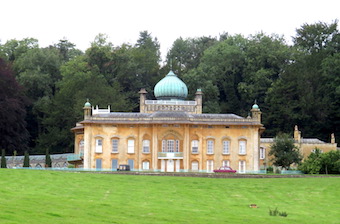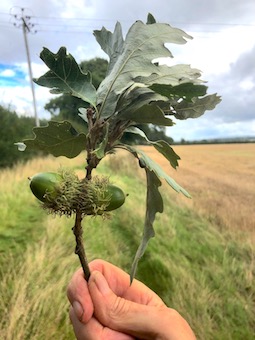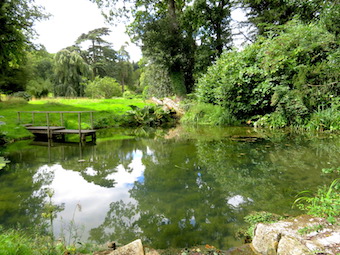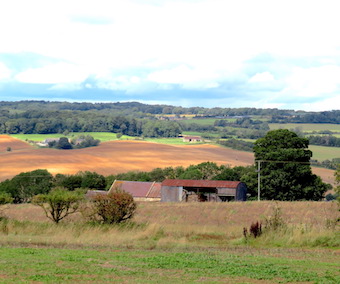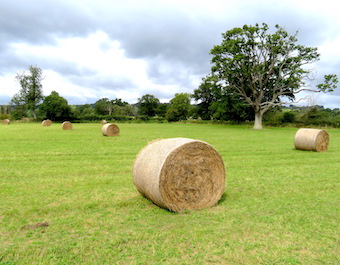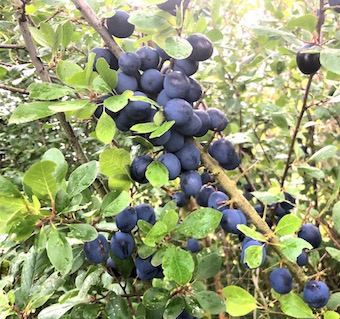It’s no surprise to discover that the Cotswolds are the favourite destination of foreign visitors to the south of England. Lying as they do across the beautiful county of Gloucestershire, only an hour from London and very handy for Shakespeare Country, Bath and Cheltenham, the Cotswolds would have to be plug-ugly and as dull as ditchwater not to be the focus of a huge amount of tourist interest. And given their manifold attractions – the villages stone-built in hues of honey and silver, the gabled towns with their ancient market houses, upmarket delicatessens and creakily characterful hotels, the footpaths and bridleways through beechwoods and hidden valleys, the seductively undulating landscape, the rich orange soil, the meadows full of race horses and well-scrubbed sheep – one can only marvel that the hills have not been thoroughly, irretrievably spoiled.
Money has played a huge part in the survival of the Cotswolds as a rural, easy-on-the-eye, timeless piece of Old England. The Romans poured out money on building villas like the splendid specimen at Chedworth, and long, straight roads such as the Fosse Way which connected (and still connects) the Roman towns of Bath and Cirencester with the north Cotswolds. It was money in the form of wool wealth, untold millions of it, that built the golden towns and wonderful churches, the market houses and great field barns of the north Cotswolds in late medieval and Elizabethan days, when Cotswold sheep carried the riches of England around on their backs. And the handsome Palladian mansions that grace the south Gloucestershire hills were built for mill owners with money earned from the spinning mills in the steep valleys below, clothing the workers of the Industrial Revolution at home and abroad.
It is the southernmost sector of the Cotswolds that holds most surprises for visitors. There are few golden stone villages here. The limestone is hard and white, the landscape far steeper and deeper than the rolling countryside usually associated with the Cotswolds. Head east from the M5 at Junctions 14 or 13, and you’ll find yourself deep in proper south Cotswold country. Along the nape of the hills runs the Cotswold Way long-distance path, a superb grandstand from which to see and get to know the area. The vast Iron Age hill fort of Uley Bury crowns its hilltop, and nearby you’ll discover secret valleys where wonderful old houses lie – the delectable silver stone Tudor manor house of Owlpen, the eerie abandoned shell of the huge Gothic pile of Woodchester Mansion. Rivers rush through the narrow valleys, and it was the power of these swift streams to turn waterwheels and power looms that saw great mills, palaces of industry, sited in the Golden Valley and other clefts near the industrial centre of Stroud. Some of the mills, such as Longford’s Mill off the Avening-Minchinhampton road, have been converted at vast expense into complexes of houses and flats; others stand magnificent and empty among the ferns and mosses of their damp, dark valleys.
Up above these hidden valleys the rich brown fields of the south Cotswold landscape can appear almost flat. Here stands the market town of Tetbury, one of the true gems of the area, its wheel of streets revolving around the hub of the old Market House. Long Street in particular is a delight, lined with crooked, honey-coloured buildings such as Porch House with its goblin gables and leaning walls. North of Tetbury, the narrow streets of the hilltop village of Minchinhampton lead to a triangular market square and a church with a curious waisted spire. The late 17th-century Market Hall and the dignified old merchants’ houses bear witness to how wool brought prosperity to south Cotswold villages. Social cachet is not the sole preserve of the north Cotswolds: both Prince Charles’s Highgrove House and Princess Anne’s Gatcombe Park lie here in the south of the region.
This area is a celebrated centre for the breeding and training of race horses. Kim Bailey, trainer of Cheltenham Gold Cup, Grand National and Champion Hurdle winners, runs his training stable at Thorndale Farm near Andoversford. ‘I love showing people around here,’ he declares, ‘it’s just so bloody beautiful.’ What is the magical attraction of racing, in a nutshell? ‘Oh, it’s very addictive. You’ve got to have a dream in life, and this is it. The Gold Cup is the pinnacle. Winning it with Master Oats in 1995 was one of the greatest moments of my life, something that no-one can ever take away from me. Quite honestly, if I dropped dead in the winner’s enclosure, I’d die a happy man.’
The A40 separates the south Cotswolds neatly from their northern neighbours. The north Cotswold landscape opens out; the land lightens in colour, widens and develops an ocean-like swell. Hundreds of miles of drystone walls divide the Cotswold fields and line the streets of towns and villages, all needing maintenance, too many of them neglected these days. The craft of stone-walling is still alive and well, though. Keep your eyes open and you’ll see wallers at work, craftspeople such as John Nicholson of the ‘Traditional Boundaries’ company. ‘We give the wall a batter,’ says John, ‘an inward slope towards the top, to let the rain slide off. The walls we build might last for hundreds of years – they’ve found Roman ones down at Chedworth Villa, 2,000 years old.’ Another local waller, Chris Ingles, enjoys coming across odd items left in old sections of wall by previous workers. ‘In one wall we kept finding little round snuff tins every metre or so, about as much as a waller would do in a day, and every sixth or seventh tin would be twice the size – pay day!’
Among the sheep farms and horse paddocks live some of the richest and most famous men and women on earth, secluded among the folded hills and steep little dells of the north Cotswolds. In honeystone villages such as Stanton and Stanway, Snowshill and Broadway, the Guitings and the Slaughters, the lovely old manor houses and the thatched cottages and tithe barns are kept in apple-pie order. Garden trees are topiarised, verges clipped, hedges immaculately laid. Much of the north Cotswold countryside is private park and estate land, very carefully and lovingly maintained. This is the Jilly Cooper face of the Cotswolds (though she, like the Royals, prefers to live in the south Cotswolds), the ‘Rutshire’ region where people are pictured floating in Versace and Aquascutum from one hunt ball and cocktail party to the next, pausing only to ride each other’s horses and partners. Chipping Campden is the archetypal north Cotswolds market town, where deep gold houses crouch under their thatched roofs, dormer windows with stone mullions peeping out like sleepy eyes under straw fringes, the High Street lined with little old shops, steep gables, pillars and porticos.
In the village of Dorn out at the northern edge of the Cotswolds, beyond the town of Moreton-in-Marsh with its wide sheep-straggle street, Sarah and Simon Righton run their exemplary Old Farm, a welcoming place of Gloucester Old Spot pigs and big sleepy Charolais cows, of lambs and dogs, with a thriving B&B business and a farm shop stuffed with their own free-range produce. ‘There’s a satisfaction to doing it the proper way,’ notes Sarah, ‘selling what we’ve produced ourselves to people who like to see where it came from.’ And Simon concurs: ‘My family have had this farm since the 1930s. My children can run about in the open air and socialise with our guests. The Cotswolds may be about tourism, and we benefit from that ourselves. But this area’s not all about tourism. We belong here – and we wouldn’t live and work anywhere else.’
Secret Cotswolds
Woodchester Mansion
Tucked down in a hidden valley south of Stroud, Woodchester Mansion is eerie and magical. This never-completed masterpiece of Victorian extravagance features stairs that go nowhere, doors that lead to nothing, and a wealth of ornamental stone carving. For details of open days, visit www.the-mansion.co.uk.
Rollright Stones
The Rollright Stones lie near Long Compton at the north-east edge of the Cotswolds. Legends say of the 4,500-year-old stone circle and the even more ancient tomb nearby that they are knights enchanted by a witch. Don’t visit at midnight if you value your life and your sanity … !
Source of the Thames
Britain’s most famous river starts life as a trickle, its source marked by an inscribed marble slab in a field near the Thames Head Inn on the Fosse Way between Cirencester and Tetbury. Gazing at the spring, it’s hard to imagine the mighty tideway that surges through London to the North Sea nearly 200 hundred miles away.
Donnington Brewery
‘We’re very old-fashioned,’ twinkles brewery manager Valentine Teal, ‘and we like it that way.’ Donnington Brewery (www.donnington-brewery.com) with its swan-haunted pond is picture-perfect, and its superb bitter is drunk only locally – its 15 pubs are sited where a horse-drawn dray could reach them and return to the brewery in one day.
Three perfect villages
Guiting Power
A tangle of lanes north of the Cheltenham to Stow-on-the-Wold road leads eventually to Guiting (pronounced ‘Gigh-ting’) Power. The houses of Guiting Power are of deep gold stone. The Norman church of St Michael sits on the ridge, while the houses dip to the village square with its post office-cum-teashop and village bakery – a rarity these days. Guiting Power boasts two pubs, the Farmer’s Arms (Donnington’s ales; see Secret Cotswolds) and the Hollow Bottom, a characterful horse-racing mecca.
Snowshill
Three miles south of Broadway lies one of the north Cotswolds’ most beautiful villages, Snowshill. The village street dips steeply downhill beside a stepped wall into the valley bottom, where the Snowshill Arms (another Donnington’s pub) welcomes all comers. In the heart of the village stands Snowshill Manor (www.nationaltrust.org.uk/snowshillmanor), an Elizabethan manor house in lovely gardens laid out in the 1920s. Just east of the village the hilltop is purple and fragrant in summer with lavender, grown in ridge-and-furrow fields.
Bisley
The South Cotswold village of Bisley, hidden away in its valley just north of the A419 Stroud-Cirencester road, forms a tight huddle of beautiful stone houses under the guardian eye of the church of All Saints with its high rocket of a spire. The village school thrives, as do the village’s two pubs – the Stirrup Cup (dogs and walkers welcome), and the cosy Bear Inn with its asymmetrical rooms and log fire. Near the Bear stands the old village lock-up, just in case anyone has one over the eight.
Where to stay
The Ormond at Tetbury
23, Long Street, Tetbury, Glos GL8 8AA
From £69 double B&B
Tel: 01666-505690
www.theormond.co.uk
The Ormond at Tetbury sits snug and discreet in the town’s most charming, be-gabled street, right opposite Prince Charles’s Highgrove shop. A very pleasing sense of quiet, relaxed style pervades the whole hotel. Rooms are done out individually, and range from a four-poster with traditional ruched curtains to a more modern Scandinavian-style simplicity. The Ormond has recently picked up a Cotswold Life Food & Drinks Award 2008, and this seal of approval by local judges tells you all you need to know about the catering standards here. The menu is long on beef from the Prince’s Duchy organic farm via the local butcher, local duck and game, Cotswold cheeses, and bread made with locally ground organic flour. Cream teas await hungry walkers in mid-afternoon. Add pleasant, polite staff and a good range of locally brewed beers, and you’d search in vain to find a better Cotswold bolt-hole.
Budget Break
Camping Field,
Old Farm, Dorn, Moreton-in-Marsh, Glos GL56 9NS
From £7 a night, caravan or tent
Tel: 01608-650394
www.oldfarmdorn.co.uk
Canvas and caravans are both welcome; you can cook up a storm, too, with the Farm Shop’s own home-produced meat and other very local produce.
Blow Out
Lords of the Manor,
Upper Slaughter, near Bourton-on-the-Water, Glos GL54 2JD
From £191 double B&B
Tel: 01451-820243
www.lordsofthemanor.com
No piped music, no sharp edges to life in this former Rectory: just peace, quiet, luxury and escapism.
If you only do one thing …
- … watch the lambs being born at Cotswold Farm Park (www.cotswoldfarmpark.co.uk) near Stow-on-the-Wold. See the ewes give birth, bottle-feed and cuddle lambs – irresistible!
- … take a stroll along the Cotswold Way in Cranham Wood (off A46, 7 miles south of Cheltenham) – one of the best bluebell woods in the Cotswolds.
- … enjoy one of the special Events Days at the National Aboretum, Westonbirt (www.forestry.gov.uk/westonbirt), near Tetbury – a wonderful display of spring flowers and blossom.
- … buy fresh local produce at Tetbury Farmer’s Market in the 17th-century Market House (9-1, first Friday every month), and local crafts and organic produce at the Highgrove shop in Long Street (www.highgroveshop.com).
- … go racing. The Cheltenham Festival (www.cheltenhamfestival2009.co.uk; 10-13 March 2009) is the biggest event in the British horse racing calendar, with the Cheltenham Gold Cup the pinnacle of the sport. If you just have to have a race horse yourself, contact Kim Bailey Racing (www.kimbaileyracing.com).
- … make a splash at the Cotswold Water Park (www.waterpark.org.uk) as you fish, sail, watch birds, canoe, go wakeboarding and water skiing, and much more.
